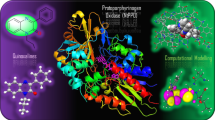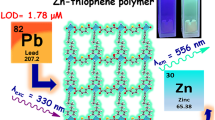Abstract
This research presents the application of Dinaphthoylated Oxacalix[4]arene (DNOC) as a novel fluorescent receptor for the purpose of selectively detecting nitroaromatic compounds (NACs). The characterization of DNOC was conducted through the utilization of spectroscopic methods, including 1H-NMR, 13C-NMR, and ESI-MS. The receptor demonstrated significant selectivity in acetonitrile towards several nitroaromatic analytes, such as MNA, 2,4-DNT, 2,3-DNT, 1,3-DNB, 2,6-DNT, and 4-NT. This selectivity was validated by the measurement of emission spectra. The present study focuses on the examination of binding constants, employing Stern-Volmer analysis, as well as the determination of the lowest detection limit (3σ/Slope) and fluorescence quenching. These investigations aim to provide insights into the inclusion behavior of DNOC with each of the six analytes under fluorescence spectra investigation. Furthermore, the selectivity trend of the ligand DNOC for NAC detection is elucidated using Density Functional Theory (DFT) calculations conducted using the Gaussian 09 software. The examination of energy gaps existing between molecular orbitals, namely the highest occupied molecular orbital (HOMO) and the lowest unoccupied molecular orbital (LUMO), provides a valuable understanding of electron-transfer processes and electronic interactions. Smaller energy gaps are indicative of heightened selectivity resulting from favorable electron-transfer processes, whereas bigger gaps suggest less selectivity attributable to weaker electronic contacts. This work integrates experimental and computational methodologies to provide a full understanding of the selective binding behavior of DNOC. As a result, DNOC emerges as a viable chemical sensor for detecting nitroaromatic explosives.
Graphical Abstract






Similar content being viewed by others
Availability of Data and Materials
Data will be available upon request.
Reference
da Costa Filho BM, Duarte AC, Rocha-Santos TAP (2022) Environmental monitoring approaches for the detection of organic contaminants in marine environments: A critical review. Trends in Environmental Analytical Chemistry 33:e00154
Liaquat H, Imran M, Latif S, Hussain N, Bilal M (2022) Multifunctional nanomaterials and nanocomposites for sensing and monitoring of environmentally hazardous heavy metal contaminants. Environ Res 214:113795
Majeed S, Junaid HM, Waseem MT, Mahmood T, Farooq U, Shahzad SA (2022) Receptor free fluorescent and colorimetric sensors for solution and vapor phase detection of hazardous pollutant nitrobenzene; a new structural approach to design AIEE active and piezofluorochromic sensors. J Photochem Photobiol A Chem 431:114022
Woodfin RL (2006) Trace chemical sensing of explosives. John Wiley & Sons
Ma H, Li B, Zhang L, Han D, Zhu G (2015) Targeted synthesis of core–shell porous aromatic frameworks for selective detection of nitro aromatic explosives via fluorescence two-dimensional response. J Mater Chem A Mater 3(38):19346–19352
Thomas SW, Joly GD, Swager TM (2007) Chemical sensors based on amplifying fluorescent conjugated polymers. Chem Rev 107(4):1339–1386
Steinfeld JI, Wormhoudt J (1998) Explosives detection: a challenge for physical chemistry. Annu Rev Phys Chem 49(1):203–232
Afzal A, Iqbal N, Mujahid A, Schirhagl R (2013) Advanced vapor recognition materials for selective and fast responsive surface acoustic wave sensors: A review. Anal Chim Acta 787:36–49
Agbaria RA, Oldham PB, McCarroll M, McGown LB, Warner IM (2002) Molecular fluorescence, phosphorescence, and chemiluminescence spectrometry. Anal Chem 74(16):3952–3962
Griffin TM, Popkie N Jr, Eagan MA, McAtee RF, Vrazel D, McKinly J (2005) Instrument response measurements of ion mobility spectrometers in situ: Maintaining optimal system performance of fielded systems. Chemical and Biological Sensing VI 5795:54–64
Czarnik AW (1998) A sense for landmines. Nature 394(6692):417–418
Gottfried JL, De Lucia FC, Munson CA, Miziolek AW (2009) Laser-induced breakdown spectroscopy for detection of explosives residues: a review of recent advances, challenges, and future prospects. Anal Bioanal Chem 395(2):283–300
Caygill JS, Davis F, Higson SPJ (2012) Current trends in explosive detection techniques. Talanta 88:14–29
Kuligowski J, Quintás G, De la Guardia M, Lendl B (2010) Analytical potential of mid-infrared detection in capillary electrophoresis and liquid chromatography: A review. Anal Chim Acta 679(1–2):31–42
Cooks RG, Ouyang Z, Takats Z, Wiseman JM (1979) (2006) Ambient mass spectrometry. Science 311(5767):1566–1570
Pablos JL, Trigo-López M, Serna F, García FC, García JM (2014) Water-soluble polymers, solid polymer membranes, and coated fibres as smart sensory materials for the naked eye detection and quantification of TNT in aqueous media. Chemical Communications 50(19):2484–2487
Salinas Y, Martínez-Máñez R, Marcos MD, Sancenón F, Costero AM, Parra M, Gil S (2012) Optical chemosensors and reagents to detect explosives. Chem Soc Rev 41(3):1261–1296
Kartha KK, Babu SS, Srinivasan S, Ajayaghosh A (2012) Attogram sensing of trinitrotoluene with a self-assembled molecular gelator. J Am Chem Soc 134(10):4834–4841
Gopalakrishnan D, Dichtel WR (2013) Direct detection of RDX vapor using a conjugated polymer network. J Am Chem Soc 135(22):8357–8362
Desai V, Panchal M, Dey S, Panjwani F, Jain VK (2021) Recent Advancements for the Recognization of Nitroaromatic Explosives Using Calixarene Based Fluorescent Probes. J Fluoresc 1–13
Germain ME, Knapp MJ (2009) Optical explosives detection: from color changes to fluorescence turn-on. Chem Soc Rev 38(9):2543–2555
Mehta V, Panchal M, Modi K, Kongor A, Panchal U, Jain VK (2015) The chemistry of nascent oxacalix [n] hetarene (n≥ 4): a review. Curr Org Chem 19(12):1077–1096
Katz JL, Feldman MB, Conry RR (2005) Synthesis of functionalized oxacalix [4] arenes. Org Lett 7(1):91–94
Vora M, Dey S, Kongor A, Panchal M, Verma A, Padhiyar N, Jain VK (2022) Design of bi-pyrene functionalized oxacalixarene probe for ratiometric detection of Fe3+ and PO43-ions. J Mol Liq 118601
Dey S, Modi K, Panchal U, Panchal M, Jain VK (2021) Detection of small molecular toxins using azacalix [4] arene architecture and its theoretical investigations. J Mol Liq 337:116337
Sutariya PG, Soni H, Gandhi SA, Soni SS, Prasad J (2021) A dual-response naphthalene-armed calix [4] arene based fluorescence receptor for Zr (IV) and Fe (II) via Ligand to metal charge transfer. Sens Actuators B Chem 331:129417
Quiroga-Campano C, Gómez-Machuca H, Moris S, Pessoa-Mahana H, Jullian C, Saitz C (2021) Synthesis of calix [4] arenes bearing thiosemicarbazone moieties with naphthalene groups: Highly selective turn off/on fluorescent sensor for Cu (II) recognition. J Mol Struct 1225:129125
Bhatti AA, Oguz M, Memon S, Yilmaz M (2017) Dual fluorescence response of newly synthesized naphthalene appended calix [4] arene derivative towards Cu 2+ and I−. J Fluoresc 27:263–270
Mao X, Yang L, Zou Z, Luo L, Zhang X, Tian D, Deng H, Li H (2015) Dye responsive optical-electrochemical-wettability on a naphthalene-appended calix [4] arene clicking surface. Sens Actuators B Chem 212:371–376
Zhang X, Chen S, Jin S, Zhang Y, Chen X, Zhang Z, Shu Q (2017) Naphthalene based lab-on-a-molecule for fluorimetric and colorimetric sensing of F− and CN− and nitroaromatic explosives. Sens Actuators B Chem 242:994–998
Bal M, Köse A, Özpaça Ö, Köse M (2023) Pyrene, Anthracene, and Naphthalene-Based Azomethines for Fluorimetric Sensing of Nitroaromatic Compounds. J Fluoresc 1–13
Jiang Z-J, Lv H-S, Zhu J, Zhao B-X (2012) New fluorescent chemosensor based on quinoline and coumarine for Cu2+. Synth Met 162(23):2112–2116
Kumar RS, Kumar SKA (2019) Highly selective fluorescent chemosensor for the relay detection of Al3+ and picric acid. Inorg Chem Commun 106:165–173
Modi K, Panchal U, Patel C, Bhatt K, Dey S, Mishra D, Jain VK (2018) Dual in vitro and in silico analysis of thiacalix [4] arene dinaphthalene sulfonate for the sensing of 4-nitrotoluene and 2, 3-dinitrotoluene. New Journal of Chemistry 42(4):2682–2691
Prata JV, Costa AI, Teixeira CM (2020) A solid-state fluorescence sensor for nitroaromatics and nitroanilines based on a conjugated calix [4] arene polymer. J Fluoresc 30(1):41–50
Barata PD, Prata JV (2020) Fluorescent Calix [4] arene-Carbazole-Containing Polymers as Sensors for Nitroaromatic Explosives. Chemosensors 8(4):128
Peveler WJ, Roldan A, Hollingsworth N, Porter MJ, Parkin IP (2016) Multichannel detection and differentiation of explosives with a quantum dot array. ACS Nano 10(1):1139–1146
Panchal M, Kongor A, Athar M, Modi K, Patel C, Dey S, Vora M, Bhadresha K, Rawal R, Jha PC (2020) Structural motifs of oxacalix [4] arene for molecular recognition of nitroaromatic explosives: Experimental and computational investigations of host-guest complexes. J Mol Liq 306:112809
Panchal U, Modi K, Dey S, Prajapati U, Patel C, Jain VK (2017) A resorcinarene-based “turn-off” fluorescence sensor for 4-nitrotoluene: Insights from fluorescence and 1H NMR titration with computational approach. J Lumin 184:74–82
Mehta V, Athar M, Jha PC, Kongor A, Panchal M, Jain VK (2017) A turn-off fluorescence sensor for insensitive munition using anthraquinone-appended oxacalix [4] arene and its computational studies. New Journal of Chemistry 41(12):5125–5132
Sarkar U, Khatua M, Chattaraj PK (2012) A tug-of-war between electronic excitation and confinement in a dynamical context. Physical Chemistry Chemical Physics 14(5):1716–1727
Sarkar U (2002) Ground and excited states reactivity dynamics of hydrogen and helium atoms
Desai AL, Bhatt K, Modi KM, Patel NP, Panchal M, Kongor A, Patel CN, Liška A (2022) Calix [4] pyrrole based scrupulous probe for track on of tryptophan: Host-guest interaction, in silico modeling and molecular docking insights. Chem Phys 554:111426
Bandyopadhyay P, Karmakar A, Deb J, Sarkar U, Seikh MM (2020) Non-covalent interactions between epinephrine and nitroaromatic compounds: A DFT study. Spectrochim Acta A Mol Biomol Spectrosc 228:117827
Sarkar U (2005) Formaldehyde decomposition through profiles of global reactivity indices
Dorafshan Tabatabai AS, Dehghanian E, Mansouri-Torshizi H, Feizi-Dehnayebi M (2023) Computational and experimental examinations of new antitumor palladium (II) complex: CT-DNA-/BSA-binding, in-silico prediction, DFT perspective, docking, molecular dynamics simulation and ONIOM. J Biomol Struct Dyn 1–23
Inac H, Ashfaq M, Dege N, Feizi-Dehnayebi M, Munawar KS, Yağcı NK, Çınar EP, Tahir MN (2023) Synthesis, Spectroscopic Characterizations, Single Crystal XRD, Supramolecular Assembly Inspection via Hirshfeld Surface Analysis, and DFT Study of a Hydroxy Functionalized Schiff base Cu (II) complex. J Mol Struct 136751
Feizi-Dehnayebi M, Dehghanian E, Mansouri-Torshizi H (2022) Biological activity of bis-(morpholineacetato) palladium (II) complex: Preparation, structural elucidation, cytotoxicity, DNA-/serum albumin-interaction, density functional theory, in-silico prediction and molecular modeling. Spectrochim Acta A Mol Biomol Spectrosc 281:121543
Milusheva M, Gledacheva V, Stefanova I, Feizi-Dehnayebi M, Mihaylova R, Nedialkov P, Cherneva E, Tumbarski Y, Tsoneva S, Todorova M (2023) Synthesis, Molecular Docking, and Biological Evaluation of Novel Anthranilic Acid Hybrid and Its Diamides as Antispasmodics. Int J Mol Sci 24(18):13855
Nikolova S, Milusheva M, Gledacheva V, Feizi-Dehnayebi M, Kaynarova L, Georgieva D, Delchev V, Stefanova I, Tumbarski Y, Mihaylova R (2023) Drug-Delivery Silver Nanoparticles: A New Perspective for Phenindione as an Anticoagulant. Biomedicines 11(8):2201
Feizi-Dehnayebi M, Dehghanian E, Mansouri-Torshizi H (2022) Probing the biomolecular (DNA/BSA) interaction by new Pd (II) complex via in-depth experimental and computational perspectives: synthesis, characterization, cytotoxicity, and DFT approach. Journal of the Iranian Chemical Society 19(7):3155–3175
Li Y, Liu K, Li W-J, Guo A, Zhao F-Y, Liu H, Ruan W-J (2015) Coordination polymer nanoarchitecture for nitroaromatic sensing by static quenching mechanism. The Journal of Physical Chemistry C 119(51):28544–28550
Funding
The authors thank the financial assistance provided by LSRBDRDO, New Delhi, through the project scheme REF. No (LSRB-01/15001/M/LSRB-373/BTB/2020).
Author information
Authors and Affiliations
Contributions
Vishv Desai: Writing- Original draft preparation, Data curation, DFT study. Manthan Panchal: Validation, Investigation. Jaymin Parikh: Computational study (writing). Krunal Modi: Formal analysis, Software. Manoj Vora: DFT study, Writing- Reviewing and Editing. Falak Panjwani: Methodology, Visualization. Vinod K Jain: Supervision, Project administration, Funding acquisition.
Corresponding authors
Ethics declarations
Ethical Approval
Not applicable
Competing Interest
The authors declare no competing interests.
Additional information
Publisher's Note
Springer Nature remains neutral with regard to jurisdictional claims in published maps and institutional affiliations.
Supplementary Information
Below is the link to the electronic supplementary material.
Rights and permissions
Springer Nature or its licensor (e.g. a society or other partner) holds exclusive rights to this article under a publishing agreement with the author(s) or other rightsholder(s); author self-archiving of the accepted manuscript version of this article is solely governed by the terms of such publishing agreement and applicable law.
About this article
Cite this article
Desai, V., Panchal, M., Parikh, J. et al. Fluorescence Quenching and the Chamber of Nitroaromatics: A Dinaphthoylated Oxacalix[4]arene’s (DNOC) Adventure Captured through Computational and Experimental Study. J Fluoresc (2023). https://doi.org/10.1007/s10895-023-03505-8
Received:
Accepted:
Published:
DOI: https://doi.org/10.1007/s10895-023-03505-8




